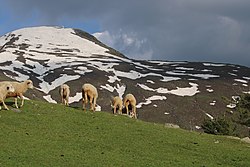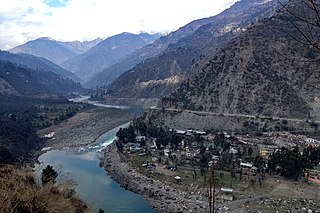
The Chenab River is a major river that flows in India and Pakistan, and is one of the 5 major rivers of the Punjab region. It is formed by the union of two headwaters, Chandra and Bhaga, which rise in the upper Himalayas in the Lahaul region of Himachal Pradesh, India. The Chenab flows through the Jammu region of Jammu and Kashmir, India, into the plains of Punjab, Pakistan, before ultimately flowing into the Indus River. The Battle of Chenab was fought between Sikhs and Afghans on the bank of the river.

Doda district is an administrative district of the Jammu division of Indian-administered Jammu and Kashmir in the disputed Kashmir region. Doda covers 2,625 square kilometers.

Banihal Pass is a mountain pass across the Pir Panjal Range in India at a maximum elevation of 2,832 m (9,291 ft). It connects the Kashmir Valley in the Indian union territory of Jammu and Kashmir to the outer Himalaya and the plains to the south. In the Kashmiri language, "Banihāl" means blizzard.
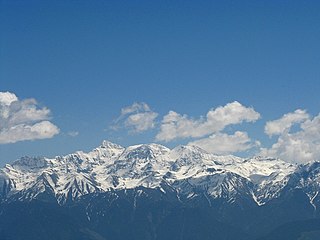
The Pir Panjal Range is a range of mountains in the Lower Himalayan region located in the Western Himalayas of northern Indian subcontinent. It runs southeast to northwest between the Beas and Neelam/Kishanganga rivers, in the Indian state of Himachal Pradesh and Indian-administered union territory of Jammu and Kashmir, with its northwestern end extending into territory administered by Pakistan. The Himalayas show a gradual elevation towards the Dhauladhar and Pir Panjal ranges. Pir Panjal is the largest and westernmost range of the Lesser Himalayas. Near the bank of the Sutlej River, it dissociates itself from the main Himalayan range and forms a divide between the Beas and Ravi rivers on one side and the Chenab on the other. Further west, the Pir Panjal range forms the southwestern boundary of the Kashmir Valley, separating it from the hills of Jammu region, forming a divide between the Jhelum and Chenab rivers.
The Jammu–Baramulla line is a railway track being laid to connect the Kashmir Valley in the Indian union territory of Jammu and Kashmir with Jammu railway station and thence to the rest of the country. The 338 km railway track will start from Jammu and end at Baramulla. It comes under the jurisdiction of the Firozpur railway division of Indian Railways's Northern zone. Part of this railway route from Udhampur to Baramulla is known as Udhampur-Srinagar-Baramula Rail Link (USBRL). The 359 m (1,178 ft) high Chenab Bridge lies on this line, which is the highest railway bridge in the world. The total project cost in 2022 was INR28,000 crore. Construction of the route faced natural challenges including major earthquake zones, extreme temperatures and inhospitable terrain.

Banihal is a town and a notified area committee, near Ramban town in Ramban district in the Indian union territory of Jammu and Kashmir. It is a rural and hilly area with Kamirwah being one of the most prominent hills. It is located about 35 km (22 mi) away from Qazigund of Anantnag district on NH 44. However, the distance between Banihal and Qazigund is only 18 km by train on the new railway line which is much shorter than the road. The most common language spoken in the region is Kashmiri; Urdu, Hindi, Gujjari, Pahari and English are other familiar languages.
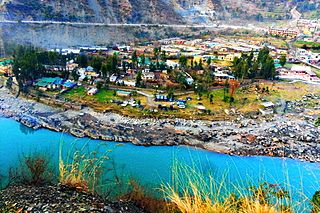
Ramban is a town in Ramban district of Jammu and Kashmir, India, which is the district headquarters of Ramban district. It lies on the banks of the Chenab river in Chenab Valley on the National Highway-1A at about 120 km from Jammu and about 130 km from Srinagar, making it almost the central point on the Jammu-Srinagar National Highway.

Jammu and Kashmir is home to several valleys such as the Kashmir Valley, Chenab Valley, Sindh Valley and Lidder Valley. Some major tourist attractions in Jammu and Kashmir are Srinagar, with its renowned Dal Lake and Mughal Gardens, Gulmarg, Pahalgam, Bhaderwah, Patnitop and Jammu. Every year, thousands of Hindu pilgrims visit holy shrines of Vaishno Devi and Amarnath which has had a significant impact on the state's economy.
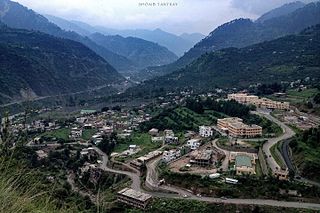
Ramban district is an administrative district in the Jammu division of Indian-administered Jammu and Kashmir in the disputed Kashmir region. It is located in a valley surrounded the Pir Panjal range. It was carved out as a separate district from erstwhile Doda district in 2007. It is located in the Jammu division. The district headquarters are at Ramban town, which is located midway between Jammu and Srinagar along the Chenab river in the Chenab valley on National Highway-44, approximately 151 km from Jammu and Srinagar.

Kishtwar district is an administrative district of the Jammu division of Indian-administered Jammu and Kashmir of the disputed Kashmir region. As of 2011, it is the largest and the least populous district of the Union Territory of Jammu and Kashmir.

Chenab Valley is a term refers to present-day districts of Doda, Kishtwar, Ramban in Jammu and Kashmir. These three districts used to be part of a single former district called Doda, which was created in 1948 out of the eastern parts of Udhampur district of the princely state of Jammu and Kashmir, and are sometimes collectively referred to as the Doda belt.
Sangaldan is a town near Ramban town in the Ramban district of the Indian union territory of Jammu and Kashmir. It falls in the Gool-Gulabgarh area of the Chenab valley.

Banihal railway station, a part of Jammu–Baramulla line, is situated in notified area of Banihal in Ramban district, Jammu and Kashmir. It was commissioned on 26 June 2013 and passenger trains run from Banihal to Qazigund. The station was inaugurated by former prime minister Manmohan Singh and UPA Chairperson Sonia Gandhi on the same day at 2.22 pm. They enjoyed the 12-minute ride in train through Pir Panjal tunnel up to Qazigund with 100 students, mostly girls, of the Banihal Higher Secondary School, and made the 17.8-km ride back to Banihal, passing through the tunnel again, the second longest in Asia.
Devi Das Thakur was an Indian politician and a former Governor of Assam.
Sangaldan Railway Station is a railway station in Ramban district, Jammu and Kashmir. Its code is SGDN. It serves Sangaldan block, Gool Sub-division and Ramban District. The station has three platforms. The station lies on Banihal–Katra line. The Work on this rail line upto Sangaldan has been completed in February 2024. The station in surrounded by many of long tunnels of Jammu–Baramulla line.
Gool Valley is a town in Ramban district of Jammu and Kashmir, India.
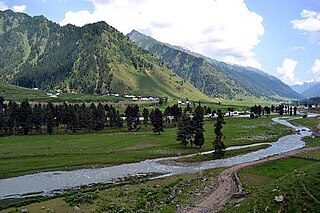
The Warwan Valley is a Himalayan sub-valley and a tehsil in Kishtwar District in the Jammu division in union territory of Jammu and Kashmir in India. The Valley lies 68 kilometres (42 mi) northeast of Kishtwar and 150 kilometres (93 mi) from Srinagar, the summer capital of Jammu and Kashmir.

Jai Valley is an enchanting valley located 32 kilometres northeast of Bhaderwah town in Jammu and Kashmir, India. The Bhaderwah-Jai road, which passes through the corniferous deodar forests of Nakshri, Balote, Bhalara and Chinta Valley connects the valley with the Bhaderwah town. The valley has green meadows which act as the attraction for tourists in summers and the snow-covered landscape during winters. Jai valley has about 9 kilometres long meadows, bisected by a stream called Jai Nallah which merges with a tributary of river Chenab at Kahara in tehsil Thathri. It is also known by the names Jai Garh and Jai Top. The valley is also connected through a 37 kilometres long road with Gandoh. There is no Mobile Network in this valley.
Pogali, or Poguli, is an Indo-Aryan language spoken in parts of the Chenab Valley in Jammu region of Jammu and Kashmir, India. Its area encompasses the Pogal and Paristan, Ramsu Banihal Khari Reasi's village and cheneni, and currently falls within the of Ramban district's .Pogali while based on Kashmiri, is much mixed with Pahari and Lahnda, and forms a transition dialect. In 1911 the number of speakers was reported to be 8,158. Like its neighbours Sarazi and Rambani, Pogali is intermediate between Kashmiri and Western Pahari.
Chanderkot is a village panchayat located in Ramban district in the Indian state of Jammu-Kashmir.
most beautiful places for tracking or campaign. Marg. Hansraj. Sunaseri. Sharwadhar. Sargali.
